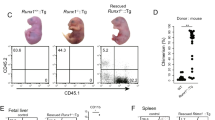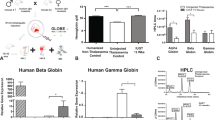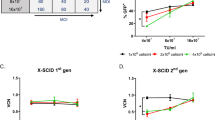Abstract
In utero injection of cationic liposome–DNA complexes (CLDCs) containing chloramphenicol acetyltransferase, β-galactosidase (β-gal), or human granulocyte colony-stimulating factor (hG-CSF) expression plasmids produced high-level gene expression in fetal rats. Tissues adjacent to the injection site exhibited the highest levels of gene expression. Chloramphenicol acetyltransferase expression persisted for at least 14 days and was reexpressed following postnatal reinjection of CLDCs. Intraperitoneal administration of the hG-CSF gene produced high serum hG-CSF levels. X-gal staining demonstrated widespread β-gal expression in multiple fetal tissues and cell types. No toxic or inflammatory responses were observed, nor was there evidence of fetal–maternal or maternal–fetal gene transfer, suggesting that CLDCs may provide a useful alternative to viral vectors for in utero gene transfer.
This is a preview of subscription content, access via your institution
Access options
Subscribe to this journal
Receive 12 print issues and online access
$209.00 per year
only $17.42 per issue
Buy this article
- Purchase on Springer Link
- Instant access to full article PDF
Prices may be subject to local taxes which are calculated during checkout






Similar content being viewed by others
References
Ledley, F.D. Prenatal application of somatic gene therapy. Obstet Gynecol. Clin. North Am. 3, 611–620 ( 1993).
Hatzoglou, M. et al. Hepatic gene transfer in animals using retroviruses containing the promoter from the gene for phosphoenolpyruvate carboxykinase. J. Biol. Chem. 265, 17285–17293 (1990).
Clapp, D.W., Dumenco, L.L., Hatzoglou, M. & Gerson, S.L. Fetal liver hematopoietic stem cells as a target for in utero retroviral gene transfer. Blood 78, 1132– 1139 (1991).
Pitt, B.R. et al. Retrovirus-mediated gene transfer in lungs of living fetal sheep. Gene Ther. 5, 344–350 ( 1995).
Hatzoglou, M., Moorman, A. & Lamers, W. Persistent expression of genes transferred in the fetal rat liver via retroviruses. Somat. Cell Mol. Genet. 4, 265–278 (1995).
Kay, M.A. et al. Hepatic gene therapy: persistent expression of human alpha 1-antitrypsin in mice after direct gene delivery in vivo. Hum. Gene Ther. 3, 641–647 (1992).
Fleischman, R.A., Custer, R.P. & Mintz B. Totipotent hematopoietic stem cells: normal self-renewal and differentiation after transplantation between mouse fetuses. Cell 30, 351– 359 (1982).
Toles, J.F., Chui, D.H., Belbeck, L.W., Starr, E. & Barker, J.E. Hematopoietic stem cells in murine embryonic yolk sac and peripheral blood. Proc. Natl. Acad. Sci. USA 86, 7456–7459 ( 1989).
Debs, R. et al. Extended, high level transgene expression in rodent lung cells ex vivo. Am. J. Respir. Cell. Mol. Biol. 7, 406– 413 (1992).
Tsukamoto, M., Ochiya, T., Yoshida, S., Sugimura, T. & Terada M. Gene transfer and expression in progeny after intravenous DNA injection into pregnant mice. Nat. Genet. 9, 243–248 (1995).
Alton, E,W. et al. Non-invasive liposome-mediated gene delivery can correct the ion transport defect in cystic fibrosis mutant mice. Nat. Genet. 5, 135–142 (1993).
Hyde, S.C. et al. Correction of the ion transport defect in cystic fibrosis transgenic mice by gene therapy. Nature 362, 250– 255 (1993).
Canonico, A.E., Conary, J.T., Meyrick, B.O. & Brigham, K.L. Aerosol and intravenous transfection of human alpha 1-antitrypsin gene to lungs of rabbits. Am. J. Respir. Cell. Mol. Biol. 10 , 24–29 (1994).
Sorscher, E.J. et al. Gene therapy for cystic fibrosis using cationic liposome mediated gene transfer: a phase I trial of safety and efficacy in the nasal airway. Hum. Gene Ther. 5, 1259– 1277 (1994).
Nabel, E.G., Plautz, G. & Nabel, G.J. Site-specific gene expression in vivo by direct gene transfer into the arterial wall. Science 249, 1285 –1288 (1990).
McCray, P.B. et al. Adenoviral-mediated gene transfer to fetal pulmonary epithelia in vitro and in vivo. J. Clin. Invest. 95 , 2620–2631 (1995).
Zhu, N., Liggitt, D., Liu, Y. & Debs, R. Systemic gene expression after intravenous DNA delivery into adult mice. Science 261, 209–211 (1993).
Philip, R., Liggitt, D., Philip, M., Dazin, P. & Debs, R.J. In vivo gene delivery: efficient transfection of T lymphocytes in adult mice. J. Biol Chem. 268, 16087– 16090 (1993).
Kawakami, M. et al. Levels of serum granulocyte colony-stimulating factor in patients with infections. Blood 76, 1962– 1964 (1990).
Ichikawa, T., Kuwaki, T., Tachibana, K., Yanagida, M. & Matsuki, S. A highly sensitive enzyme immunoassay for G-CSF in human plasma. Exp. Hematol. 23, 192–195 (1995).
Liu, Y. et al. Cationic liposome-mediated intravenous gene delivery in mice. J. Biol. Chem. 27, 24864–24870 (1995).
Gilgenkrantz, H. et al. Transient expression of genes transferred in vivo into heart using first-generation adenoviral vectors: role of the immune response. Hum. Gene Ther. 6, 1265–1274 (1995).
Walter, J., You, Q., Hagstrom, JN., Sands, M. & High, K.A. Successful expression of human factor IX following repeat administration of adenoviral vector in mice. Proc. Natl. Acad. Sci. USA 93, 3056–3061 (1996).
Thierry, A.R. et al. Systemic gene therapy: biodistribution and long-term expression of a transgene in mice. Proc. Natl Acad. Sci. USA 92, 9742–9746 (1995).
Cooper, M.J. et al. Safety-modified episomal vectors for human gene therapy. Proc. Natl. Acad. Sci. USA 94, 6450– 6455 (1997).
Hong, K., Zheng, W., Baker, A., & Papahadjopoulos, D. Stabilization of cationic liposome-plasmid DNA complexes by polyamines and poly(ethylene glycol)-phospholipid conjugates for efficient in vivo gene delivery. FEBS Lett. 400, 233–237 (1997).
Templeton, N.S. et al. Improved DNA: liposome complexes for increased systemic delivery and gene expression. Nat. Biotechnol. 15, 647–652 (1997).
Stewart, M.J. et al. Gene transfer in vivo with DNA–liposome complexes: safety and acute toxicity in mice. Hum. Gene Ther. 3, 267–275 (1992).
Canonico, A.E., Plitman, J.D., Conary, J.T., Meyrick, B.O. & Brigham K.L. No lung toxicity after repeated aerosol or intravenous delivery of plasmid–cationic liposome complexes. J. Appl. Physiol. 77, 415– 419 (1994).
Vincent, M.C. et al. Adenovirus-mediated gene transfer to the respiratory tract of fetal sheep in utero. Hum. Gene Ther. 8, 1019– 1028 (1995).
Yang, Y. et al. Cellular immunity to viral antigens limits E1-deleted adenoviruses for gene therapy. Proc. Natl. Acad. Sci. USA 91, 4407–4411 (1994).
Sekhon, H.S. & Larson, J.E. In utero gene transfer into the pulmonary epithelium. Nat. Med. 1, 1201– 1203 (1995).
Larson, J.E., Morrow, S.L., Happel, L., Sharp, J.F. & Cohen, J.C. Reversal of cystic fibrosis phenotype in mice by gene therapy in utero. Lancet 349, 619– 620 (1997).
Halbert, C.L. et al. Transduction by adeno-associated virus vectors in the rabbit airway: efficiency, persistence, and readministration. J. Virol. 71, 5932–5941 (1997).
Kafri, T. et al. Cellular immune response to adenoviral vector infected cells does not require de novo viral gene expression: implications for gene therapy. Proc. Natl. Acad. Sci. USA 95, 11377– 11382 (1998).
Iwamoto, H.S., Trapnell B.C., McConnell C.J., Daugherty, C. & Whitsett, J.A. Pulmonary inflammation associated with repeated, prenatal exposure to an E1, E3-deleted adenoviral vector in sheep. Gene Ther. 6, 98– 106 (1999).
Ketteler, M., Noble, N.A. & Border, W.A. Increased expression of transforming growth factor-beta in renal disease. Curr. Opin. Nephrol. Hypertens. 3 , 446–452 (1994).
Bartke, A. et al. Neuroendocrine and reproductive consequences of overexpression of growth hormone in transgenic mice. Proc. Soc. Exp. Biol. Med. 206, 345–359 (1994).
Holtzman, D.M., Sheldon, R.A., Jaffe, W., Cheng, Y. & Ferriero, D.M. Nerve growth factor protects the neonatal brain against hypoxic-ischemic injury. Ann. Neurol. 39, 114–122 (1996).
Low, J.A. The relationship of asphyxia in the mature fetus to long-term neurologic function. Clin. Obstet. Gynecol. 36, 82– 90 (1993).
Paneth, N. & Stark, R.I. Cerebral palsy and mental retardation in relation to indicators of perinatal asphyxia. An epidemiologic overview. Am. J. Obstet. Gynecol. 147, 960– 966 (1983).
Mason, C.A. et al. Gene transfer in utero biologically engineers a patent ductus arteriosus in lambs by arresting fibronectin-dependent neointimal formation. Nat. Med. 5, 176–182 ( 1999).
Kurth, R. Risk potential of the chromosomal insertion of foreign DNA. Ann. NY Acad. Sci. 772, 140–151 (1995).
Sambrook, J., Fritsch, E.F. & Maniatis, T. in Molecular cloning: a laboratory manual 2nd edn (eds Ford, N., Nolan, C. & Ferguson, M.) (Cold Spring Harbor Laboratory Press, Cold Spring Harbor, New York; 1989).
Solodin, I. et al. A novel series of amphiphilic imidazolinium compounds for in vitro and in vivo gene delivery. Biochemistry 34, 13537–13544 (1995).
Mounkes, L. et al. In vivo transfection of animals by intravenous injection of cationic liposome:DNA complexes. J. Lipid Res. 7, 161–176 (1997).
Olson, F., Hunt, C.A., Szoka, F.C., Vail, W.J. & Papahadjopoulos, D. Preparation of liposomes of defined size distribution by extrusion through polycarbonate membranes. Biochim. Biophys. Acta 557, 9–20 ( 1979).
Johnston, R.F., Pickett, S.L. & Barker, D.L. Autoradiography using storage phosphor technology. Electrophoresis 11, 355– 360 (1990).
Bout, A., Valerio, D. & Scholte, B.J. In vivo transfer and expression of the lacZ gene in the mouse lung. Exp. Lung Res. 19, 193– 202 (1993).
Gaensler, K.M., Kitamura, M. & Kan, Y.W. Germ-line transmission and developmental regulation of a 150-kb yeast artificial chromosome containing the human beta-globin locus in transgenic mice. Proc. Natl Acad. Sci. USA 90, 11381–11385 (1993).
Acknowledgements
This work was supported by NIH grants DK45917, DK49550, and HL53762. We thank Patrick Lewis for performing the hG-CSF assays.
Author information
Authors and Affiliations
Corresponding author
Rights and permissions
About this article
Cite this article
Gaensler, K., Tu, G., Bruch, S. et al. Fetal gene transfer by transuterine injection of cationic liposome–DNA complexes. Nat Biotechnol 17, 1188–1192 (1999). https://doi.org/10.1038/70729
Received:
Accepted:
Issue Date:
DOI: https://doi.org/10.1038/70729
This article is cited by
-
In vivo genome editing targeted towards the female reproductive system
Archives of Pharmacal Research (2018)
-
In vivo electroporation in the embryonic mouse central nervous system
Nature Protocols (2006)
-
Nonviral gene transfer into fetal mouse livers (a comparison between the cationic polymer PEI and naked DNA)
Gene Therapy (2003)
-
Possible mechanism of gene transfer into early to mid-gestational mouse fetuses by tail vein injection
Gene Therapy (2002)
-
Fetal immunization by a DNA vaccine delivered into the oral cavity
Nature Medicine (2000)



